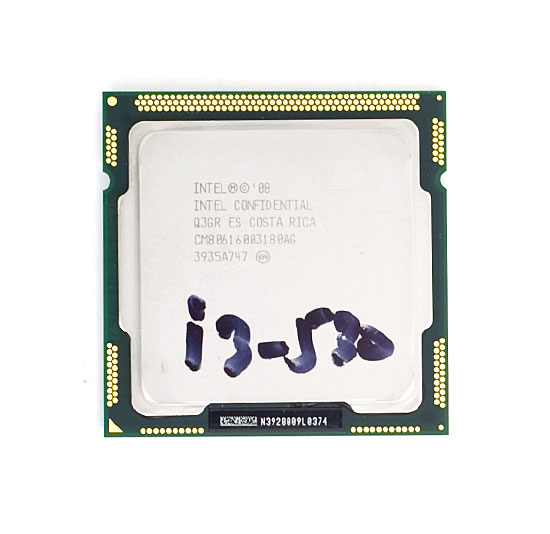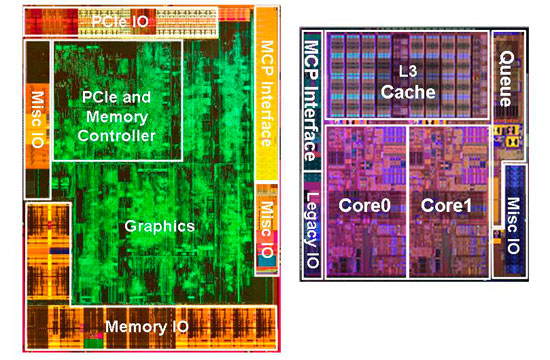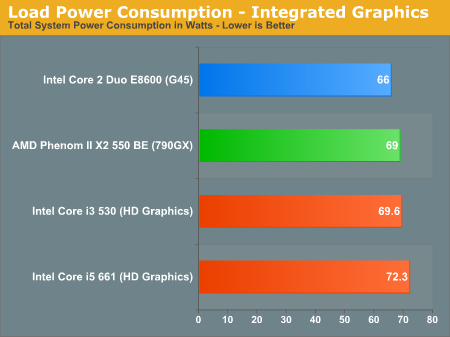The Intel Core i3 530 Review - Great for Overclockers & Gamers
by Anand Lal Shimpi on January 22, 2010 12:00 AM EST- Posted in
- CPUs
It’s about time we got an interesting value processor to review from Intel. I simulated one in our Clarkdale review, but today I’m bringing you a full review of the most interesting dual-core Westmere for the desktop - the Core i3 530.

Priced at $113 (and selling for about $125 on the street) the 530 runs at 2.93GHz and features no turbo modes. It’ll run at 1.33GHz at its lowest frequency, and no faster than 2.93GHz at full load. The missing turbo boost is almost all you sacrifice as the 530 still has a hefty 4MB L3 cache shared between both cores. Each core gets a 256KB 10-cycle L2, just like the i5s and i7s.
The un-core is clocked at 2.13GHz, down from 2.40GHz in the i5. That should hurt performance a bit compared to our simulated i3 in the launch article. Aside from Turbo the other thing you give up with the i3 is AES acceleration. Westmere's AES New Instructions (AES-NI) are disabled on all of the i3s in typical Intel fashion. There has to be some reason for users to opt for a Core i5 instead.
| Processor | Core | Un-core | GPU | Cores / Threads | L3 Cache | Max Turbo | TDP | Price |
| Intel Core i5-670 | 3.46GHz | 2.40GHz | 733MHz | 2 / 4 | 4MB | 3.76GHz | 73W | $284 |
| Intel Core i5-661 | 3.33GHz | 2.40GHz | 900MHz | 2 / 4 | 4MB | 3.60GHz | 87W | $196 |
| Intel Core i5-660 | 3.33GHz | 2.40GHz | 733MHz | 2 / 4 | 4MB | 3.60GHz | 73W | $196 |
| Intel Core i5-650 | 3.20GHz | 2.40GHz | 733MHz | 2 / 4 | 4MB | 3.46GHz | 73W | $176 |
| Intel Core i3-540 | 3.06GHz | 2.13GHz | 733MHz | 2 / 4 | 4MB | N/A | 73W | $133 |
| Intel Core i3-530 | 2.93GHz | 2.13GHz | 733MHz | 2 / 4 | 4MB | N/A | 73W | $113 |
| Intel Pentium G9650 | 2.80GHz | 2.00GHz | 533MHz | 2 / 2 | 3MB | N/A | 73W | $87 |
Sitting next to the 32nm CPU die is a 45nm GPU/memory controller:

Like the majority of the Core i5 processors, the GPU here runs at 733MHz. The exception being our recently reviewed 661 which runs the GPU at 900MHz for those who want that extra bit of mediocre gaming performance.
From Intel the closest competitor is the Core 2 Duo E7600, which runs at 3.06GHz but with a 3MB L2 cache. AMD provides the biggest threat with its Athlon II X4 630 and Phenom II X2 550 BE. The latter isn't on AMD's official price list but you can still find it online today for $99.
In a market full of good alternatives, whether it’s an ultra-cheap quad-core or a solid dual-core, it’s time to find out if there’s any value in the Core i3 530.
Fixes Since Last Time
There were two outstanding issues in our Clarkdale review that needed fixing after CES. First and foremost was power consumption. We incorrectly assumed that Clarkdale's idle power consumption was worse than Lynnfield due to the 45nm on-package chipset. As many of you pointed out, it was an issue with our ASUS H57 motherboard. After CES we switched over to Gigabyte's GA-HS57M-USB3 and the idle power consumption improved considerably. Since then ASUS appears to have fixed the problem but our data for this review was still run with Gigabyte's board.

Unfortunately these sorts of issues aren't rare with any new motherboard/chipset release. Our ASUS H57 board had idle power issues, while our Gigabyte H57 board had overclocking issues. No one seems to get it right on the first try.
The second issue that needs correcting is the system power consumption while playing back an x264 video using integrated graphics. Our AMD numbers were unusually high in our initial review, which we've since corrected:

While playing H.264 encoded video the GPU does all of the heavy lifting and there's no power advantage for Clarkdale to rest on. When watching a movie the AMD system is indistinguishable from our Clarkdale test bed.
We are still running into an issue with MPC-HC and video corruption with DXVA enabled on the 790GX, but haven't been able to fix it yet. Have any of you had issues with video corruption with AMD graphics and the latest stable build of MPC-HC for 64-bit Windows? Or should we chalk it up to being just another day in the AnandTech labs.










107 Comments
View All Comments
marc1000 - Friday, January 22, 2010 - link
its interesting how close in performance the e8600 is to the i3... of course you loose some power efficiency but if you already have a good discrete GPU and a e8600 (or another older penryn clocked to e8600 levels, as it is my case), then none of the new CPU's are ground-breaking deals... they are faster, of course, but they are also expensive. not funny. going from a P4 to a Penryn was really great, but from a Penryn to these new ones... its just "good".Grooveriding - Friday, January 22, 2010 - link
Any chance of seeing some comparisons of this chip at 4ghz vs an i7 920 at 4ghz. I'd love to get an idea of how it compares clock for clock in gaming against the 1366 platform.Be interesting to see if it's better just getting this if you're a gamer.
cmdrdredd - Friday, January 22, 2010 - link
2.66Ghz i7 920 vs 2.93Ghz i3 530 is already there. The 2.66Ghz i7 is on average 10fps faster. Overclocking both to 4Ghz would have the same results if not even furthering the gap. Why? Because a slower clock speed CPU is already faster. So equaling the clock speed doesn't mean equaling performance.strikeback03 - Friday, January 22, 2010 - link
Even better, if they could add overclocked results they already have to Bench.ltcommanderdata - Friday, January 22, 2010 - link
I'm wondering if overclocking the IGP's shader units overclocks the memory controller as well since they are on the same die? That would help explain the good performance scaling. As well, was power consumption significantly different with the IGP at 1200MHz? If not, then Intel should definitely have clocked their IGPs higher. Catching up to current gen IGPs from nVidia and ATI is noteworthy for an Intel IGP, but presumably nVidia and ATI have their next gen IGPs right around the corner and Intel's IGP doesn't push new performance boundaries.IntelUser2000 - Monday, January 25, 2010 - link
No, the IGP is on its own clock domain. You can overclock the iGPU seperately from everything, even the base clock. On the motherboards which allow overclocking of the iGPU on Clarkdale, you don't have multiplier options, but a straightforward frequency adjustment.Abhilash - Friday, January 22, 2010 - link
sysmark is absurdAbhilash - Friday, January 22, 2010 - link
http://www.anandtech.com/bench/default.aspx?p=112&...">http://www.anandtech.com/bench/default.aspx?p=112&...karlkesselman - Friday, January 22, 2010 - link
hi,On page 2, Load Power Consumption you have i870 using less power than i750. This can't be. It's either a misprint or the "load" test doesn't fully stress the i870 or maybe some hardware misconfiguration.
Then there is the WoW test.
i750 has 92 fps
i530 has 77 fps
and
i530 (OC @ 4 GHz) has also 92 fps
We know that WoW only uses 2 cores so i750 must be having turbo boost enabled running @ 3.2 GHz. That explains why it gets 92 fps. But then the i530 @ 4 GHz gets the same fps. This is either a mistake (was the test running the same hardware?) or i530 is less efficient then i750 (at least running WoW; maybe because of the memory controller and/or the 8 MB L3 cache or both?).
Also in this case (WoW test) it would be interesting if we could see the power consumption during the test (i750 compared to i530).
Anand Lal Shimpi - Friday, January 22, 2010 - link
Our 870 has always used slightly less power than our 750 sample. A while ago Intel did away with having a single voltage for each product shipped. In my experience, the higher end chips are usually the ones that can run at the lowest voltages.All of our Core i7/i5 numbers are run with Turbo enabled, but remember that Clarkdale's memory performance isn't as good as Lynnfield. We see this manifest itself in more than just WoW. If you have the money, you're better off with Lynnfield. But at $113 you're at nearly half the price of the cheapest Lynnfield.
Take care,
Anand